Physical Address
304 North Cardinal St.
Dorchester Center, MA 02124
Cutaneous basal cell carcinomas (BCCs) and squamous cell carcinomas (SCCs) are the most frequent cancers worldwide. Caucasian populations residing in locations with high level exposure to ultraviolet (UV) radiation, such as Australia and New Zealand and the Southern United States, have a particularly high lifetime risk for developing skin cancer.
The natural history of skin cancers varies widely with the histologic type, ranging from tumors with an indolent course and a high cure rate of 90% to 95% (e.g., BCC, low-risk SCC) to aggressive tumors with high (30% to 50%) mortality rates (e.g., Merkel cell carcinoma [MCC]).
After biopsy confirmation, patients should be staged with history and physical examination and, when indicated, blood chemistry, chest radiographs, contrast-enhanced computed tomography (CT), magnetic resonance imaging (MRI), or positron emission tomography (PET)/CT scans. Sentinel lymph node biopsy (SLNB) is indicated in select patients with MCC and investigational in those patients at high risk of SCC.
Surgery is the primary treatment for most skin cancers. Nonsurgical treatment, such as radiotherapy (RT), may be preferable for treating select BCCs and SCCs, particularly on and around the midface (e.g., nose, lower eyelids), lips, and ears because it may lead to better functional and cosmetic results than surgery. Topical and locally destructive treatments may also be effective in cases of superficial (1 mm to 2 mm) skin cancer.
In patients with BCCs and SCCs, the indications for postoperative (or adjuvant) RT include the presence of close or positive surgical margins, perineural invasion (PNI), invasion of bone or cartilage, and extensive skeletal muscle infiltration. Most patients with MCC should be considered for wide-field adjuvant RT. Patients with a high incidence of occult nodal spread (and not undergoing an SLNB) may benefit from elective nodal treatment, often wide-field RT that may also encompass the primary site (e.g., select high-risk SCC, most MCC). No effective systemic adjuvant therapy is currently available for nonmelanoma skin cancers (NMSCs). The addition of concurrent chemotherapy with RT in select high-risk cases may be considered, but is not supported by high-level evidence. The emergence of targeted immunomodualtors (PD 1 inhibitors), especially in metastatic MCC, has been associated with improved outcome in responding patients.
Surgery with adjuvant RT is the standard treatment for locally advanced and operable tumors. In certain patients, definitive RT (often hypofractionated) can still offer an excellent possibility of achieving local control (80% to 95%) in patients with locally advanced carcinomas who are either medically unable to undergo surgery or whose tumor is technically nonresectable. In unwell patients unsuitable for an extended course of definitive RT, a short course (one to four fractions) of RT can reduce symptoms for most patients with advanced inoperable cancer or with metastatic masses (e.g., pain, discharge, bleeding).
Cutaneous BCC and SCC, the most common malignancies in the world, occur at epidemic rates in high UV-exposed countries such as Australia, New Zealand, and the Southern United States. Collectively, these two carcinomas account for most (95%) patients with NMSC and are far more common than malignant melanomas, which account for only 5% of all skin malignancies. BCC is the most common type of NMSC, with an incidence of more than twice that of SCC. Other NMSCs that are infrequently encountered include MCC, also known as primary cutaneous neuroendocrine carcinoma, a rare small-cell carcinoma originally described by Toker in 1972, adnexal carcinomas such as sebaceous gland carcinomas accounting for less than 1% of all skin cancers, and eccrine carcinomas accounting for less than 0.01% of malignancies of the skin. NMSCs may be disfiguring and associated with local morbidity, and excluding MCC, are rarely lethal.
Sun exposure is the main etiologic factor for NMSC, particularly in Caucasians, whose skin is susceptible to the chronic carcinogenic effect of UV light. Other less-common etiologic factors include exposure to chemical carcinogens (e.g., arsenic, tar, anthracene, and crude paraffin oil), chronic irritation or inflammation, and ionizing radiation.
The incidence and aggressiveness of SCC and MCC (both immunogenic carcinomas) are markedly increased in individuals with compromised immune function, including patients with non-Hodgkin's lymphoma, chronic lymphocytic leukemia, and organ transplant recipients with iatrogenic immunosuppression. In contrast, the incidence of BCC is not markedly increased, and the outcome is similar as for patients who are immunocompetent.
Some genetic syndromes are also associated with a much higher risk of developing skin carcinoma. Individuals with xeroderma pigmentosum are susceptible (up to 10,000 fold increase) to developing BCC and SCC at a young age because of defective repair of UV light-induced DNA damage. These patients usually die in their early 20s from disseminated SCC or multiple myeloma. The basal cell nevus syndrome (or Gorlin's syndrome) is a rare genetic form of BCC inherited through an autosomal-dominant gene usually associated with numerous (sometimes hundreds) BCCs developing in early adulthood both in sun-exposed and nonexposed areas. Of note, 85% carry the PTCH1 gene mutation. Individuals with epidermodysplasia verruciformis tend to develop nodules of SCC within large verrucous plaques in the third and fourth decades of life.
Unprotected sun exposure, especially during the summer, is the main determinant for the subsequent development of skin cancer. Children and adolescents should be especially educated in regard to sun protection. The damage of excessive UV exposure is irreversible; despite this, adults can still reduce their risk by avoiding further excessive UV exposure. Preventive measures to reduce skin cancer include avoidance of sunlight exposure—particularly limiting time spent outdoors between 10 am and 3 pm —and wearing protective physical barriers, such as hats and clothing. If sun exposure cannot be limited because of occupational, cultural, or other factors, the use of sunscreens that are either opaque or that block UVA and UVB radiation is recommended. The use of tanning booths is also a factor in the risk of developing skin cancer, and guidelines regarding their appropriate use should be followed.
Sparse high-level evidence does indicate that the regular application of topical sunscreen protection in the general population reduces the development of new skin cancers, compared with discretionary application; however, this should not preclude a recommendation of taking sensible precautions and using sunscreens when appropriate.
Basal cell carcinoma constitutes approximately 80% of all NMSC and is the most common malignancy worldwide. Most BCCs arise on the sun-exposed head and neck (80% to 85%); lesions occur less frequently on the trunk or extremities. Lesions may manifest as an asymptomatic nodule, a pruritic plaque, or a bleeding ulcer that characteristically waxes and wanes. Many (up to 40% to 50%) patients treated for BCC develop at least one or more further BCC within 5 years. Careful evaluation of sun-exposed skin should therefore be part of any follow-up examination.
There are numerous variants of BCC, each of which has distinctive clinical and histologic features and natural history. The characteristics of commonly occurring types are briefly summarized.
Nodular BCC, colloquially referred to as rodent ulcer, is the most frequently observed variant; it accounts for approximately 50% of all lesions ( Fig. 47.1 ). It arises as a distinct papule that may develop central umbilication, progressing to central ulceration. The margins of this lesion appear pearly (pale and translucent) and contain enlarged capillaries (telangiectasia). Histologic features include the presence of large islands of monomorphous basaloid cells, varying in size and shape, embedded in a fibroblastic stroma in the dermis. The basaloid cells have large, oval hyperchromatic nuclei, scant cytoplasm, and no intercellular bridges. The peripheral cell layer of the aggregate frequently shows palisading, whereas central cells are less organized. Nodular BCC may show a varying degree of pigmentation (blue, brown, or black), depending on the number of melanocytes present in the lesion, and may be difficult to differentiate clinically from MM.
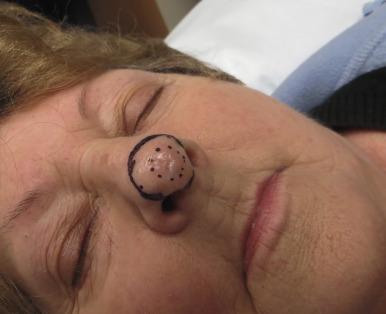
Superficial BCC manifests as red, scaly macules with indistinct margins, usually located on the trunk. It enlarges into a crusted, erythematous patch without induration that may be difficult to differentiate clinically from solar keratosis, psoriasis, SCC in situ , or extramammary Paget's disease. Histologic examination shows multiple foci of buds of neoplastic cells with peripheral palisading originating from the undersurface of the epidermis.
Morpheic (sclerosing) BCCs appear as single flat, indurated, ill-defined macules. The lesions generally have a smooth, shiny surface that becomes depressed as it grows into a plaque. It is characterized histologically by the presence of small groups and narrow strands of basaloid cells embedded in a dense, fibrous connective tissue; there is little peripheral palisading. Morpheic BCC have a propensity to recur if not appropriately treated, and PNI is often reported to be present.
Infiltrative BCC has an opaque yellowish appearance and blends subtly with the surrounding skin. Histologically, the lesion is characterized by poorly circumscribed spiky cell aggregates in the superficial portion and the main bulk, consisting of strands of neoplastic cells infiltrating the reticular dermis and subcutis.
The biologic behavior of BCC varies with the histologic type. A superficial BCC may remain stable for a long time or enlarge gradually over many years to become a nodulo-ulcerative variant. Nodular BCC grow slowly over many years by peripheral and deep invasion, particularly along embryonal fusion planes. Morpheic and infiltrative BCCs are more aggressive variants that may infiltrate deeper structures. The finding of PNI in BCC is uncommon (2% to 3% of patients), and generally occurs in the setting of recurrent disease or in morpheic histology. Compared with PNI in SCC, patients have a relatively favorable prognosis, although the treatment is similar. Lesions located around the orbit with PNI present may gain access to the orbit via the first or second division of the trigeminal nerve.
High-risk BCC occur in the midface, or so-called H zone ( Fig. 47.2 ), which includes the periauricular region, glabella, medial canthus, nose, nasolabial region, and columella, and contains embryonal fusion planes. BCC may also be large (>10 mm) and/or recurrent and many will benefit from adjuvant RT. The depth of invasion of tumors in this region is frequently underestimated, often leading to inadequate excision, especially deep, and a higher rate of local recurrence without further treatment. Histologic examination often reveals extensive infiltration of deeper structures by small nests of undifferentiated basal cells. This type of lesion may invade the orbit, nose, and maxilla, resulting in significant deformity ( Fig. 47.3 ). It should be readily recognized and treated promptly, often necessitating extensive surgery with or without adjuvant RT.
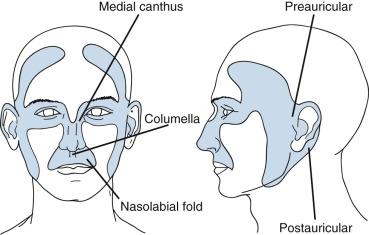
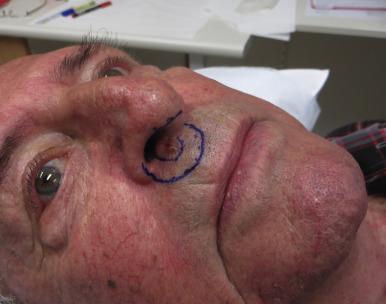
The BCC rarely spreads to the regional lymph nodes or distant organs with an overall incidence of metastasis less than 0.01%. Most metastases occur in the regional lymph nodes with distant spread usually preceded by regional metastasis. Regional disease typically develops in association with large, ulcerated lesions in the head and neck that have recurred despite treatment.
Squamous cell carcinoma arises from epidermal keratinocytes and, most commonly, develops from skin exhibiting solar (or UV) damage. Actinic (or solar) keratosis (AK) is generally a precursor or premalignant lesion, and at least 50% to 60% of all invasive SCCs arise from AK. Although quality data are lacking, only a very small minority (<5%) AK will progress to become invasive SCC over time. Many AK will also spontaneously regress, although up to 50% will recur. Less frequently, SCC arise from other preexisting skin lesions, such as arsenic keratosis, a thermal burn scar, or a chronic ulcer. Rarely, it arises from normal-appearing skin.
Clinically, SCC in situ (Bowen's disease) manifests as a soft, erythematous, scaly, well-circumscribed red patch ( Fig. 47.4 ). Slow progression is typical, and facial lesions may eventually become large and unsightly. RT, an option in select cases, is associated with an excellent outcome. Superficial SCC manifests as a scaly, crusted plaque or ulcer with a verrucous or papillate border, but invasive SCC can manifest as a firm, ulcerated mass with an elevated nodular border.
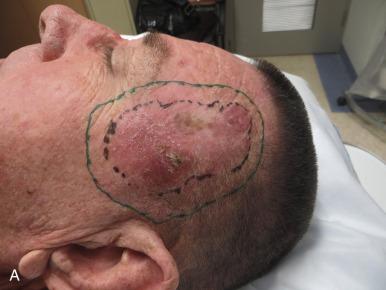
Microscopically, SCC is composed of strands and sheets of atypical keratinocytes and referred to as SCC in situ when atypical keratinocytes are confined to the epidermis. Superficial SCC represents atypical keratinocyte proliferation confined to the upper reticular dermis, whereas infiltrating SCC denotes disease extension into and beyond the lower reticular epidermis.
Histologically, SCC is graded as well, moderately, or poorly differentiated, based on the degree of cellular polymorphism, keratinization, and mitosis. The spindle cell variant mimics other skin tumors, such as amelanotic melanoma, and may require a panel of immunohistochemical studies for complete characterization.
Generally, SCC has a more aggressive course than BCC. SCC in situ (Bowen's disease) may evolve very slowly (months to years) into superficial (microinvasive) carcinoma in approximately 5% of cases. Untreated, it may progress further into an infiltrating type that invades the surrounding and underlying structures ( Fig. 47.5 ). The rate of progression depends on the degree of cellular differentiation.
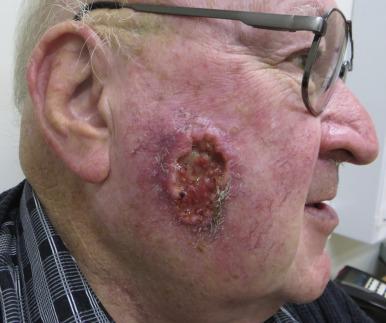
The risk of developing metastases, usually nodal, is markedly higher in SCC than in BCC (rare event). However, most patients who are immunocompetent with small (<2 cm), thin (<4 mm to 5 mm thick), nonrecurrent lesions are at low (<5%) risk of developing nodal metastases. Patients not meeting these criteria are often referred to as high-risk patients (>10% risk), and appropriate awareness and management are required. Recurrent lesions in close proximity (forehead, temple, ear, cheek) to the parotid gland increase this risk. Data suggest that tumor thickness >6mm is a powerful, independent predicator of patients at increased the risk for developing regional metastases, and as this risk increased, these lesions increased in diameter more than 2 cm.
The most frequent sites for the development of metastatic cutaneous SCC are the parotid gland, the cervical lymph nodes, or both, reflecting the high incidence of primary SCC in the head and neck region ( Fig. 47.6 ). In 20% to 25% of cases, an obvious index lesion is not identified. Invariably, these patients have a long-standing history of actinopathy and NMSC. The development of distant metastases (e.g., lung, liver) rarely occurs as a first site of relapse; it is more often encountered after treatment for nodal relapse.
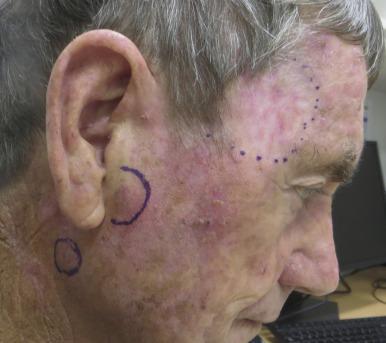
Metastatic SCC occurs less frequently in other nodal regions, such as the axilla and groin. Although difficult to quantify, the ratio of metastatic head and neck SCC to non–head and neck SCC is approximately 9:1. There are much fewer published data on the management of these patients, but analogous generalizations from the evidence on parotid and neck nodal metastases suggest operable patients should undergo surgical resection. Many will have unfavorable features, such as extranodal spread and incomplete margins, and should be recommended for adjuvant RT.
An aggressive cutaneous malignancy MCC often manifests as a rapidly enlarging, firm, painless, pink-red, dermal-based nodule, frequently on the head and neck (50% to 60%) ( Fig. 47.7 ) or extremities/trunk in older (>60 to 70 years of age) individuals. In contrast to other types of NMSC, MCCs frequently occur in women. MCC is often clinically misdiagnosed because it may resemble BCC or amelanotic melanoma. The median size of the primary lesion at diagnosis is approximately 2 cm, and the incidence of clinical nodal involvement at presentation is approximately 20% to 25%, although the risk of harboring subclinical nodal disease is high (30% to 40%). The incidence of MCC varies globally. It is thought to be increasing and is highest in those countries with an increased incidence of skin cancer. Data from the United States suggest a dramatic 300% increase in the incidence and mortality of MCC in the last 20 to 30 years. Despite current treatment, 30% to 40% of patients die from MCC.
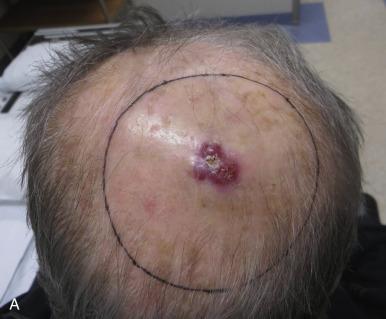
The cell of origin is thought to be the dermal neurotactile cell arising from the neural crest first described by Merkel. Lesions usually involve the reticular dermis and subcutaneous tissues, with minimal extension to the papillary dermis and sparing of the epidermis. Lymphovascular invasion is common, and clinically such permeation often manifests as in-transit metastasis. The neoplastic cells exhibit cytoplasmic extensions and small, uniform, membrane-bound neurosecretory granules on ultramicroscopic examination. Several immunohistochemical markers have been identified in MCC. The neoplastic cells stain most consistently with polyclonal antisera to neuron-specific enolase and calcitonin, monoclonal antibody to neurofilament, and cytokeratin (CK 20 positive) in 95% of cases.
Evidence suggests a viral association in the development of MCC. The Merkel cell polyomavirus (MCV) was first identified in 2008, and in various studies has been identified in around 80% of MCC tumors, mainly in patients in the Northern Hemisphere. It is postulated that MCV in certain populations (e.g., Australians) plays less of a role compared with the mutagenic consequences of chronic UVB exposure. The virus is considered part of normal human flora and is also present in healthy tissue from the general population. The prognosis of patients in the presence of MCV is also unclear with separate studies suggesting no difference, a better or a worse outcome, respectively. In part, this may explain some of the variation in outcome between different populations with MCC who have been treated. Clinical management is currently unaltered whether a patient's tumor contains MCV or not.
Merkel cell carcinoma can exhibit an aggressive course characterized by a propensity for local recurrence even after wide surgical excision and a high incidence of nodal involvement (20% to 30% clinically present at diagnosis) with hematogenous dissemination a frequent site of relapse and death. Most series document a cancer-specific death rate of around 30%. Patients may also present with metastatic nodal disease without an obvious index lesion. Such patients make up 10% to 15% of many series and have a much better prognosis compared with patients with concomitant nodes and an index lesion. MCC is a highly immunogenic carcinoma. Patients who are immunosuppressed (organ transplant recipients) and patients diagnosed with non-Hodgkin's lymphoma and chronic lymphocytic leukemia are at markedly higher risk of developing MCC and having a poor outcome and often account for up to 10% of all patients with MCC. The role that the MCV plays in the pathogenesis of MCC may account for its higher incidence in patients who are immunosuppressed.
Become a Clinical Tree membership for Full access and enjoy Unlimited articles
If you are a member. Log in here